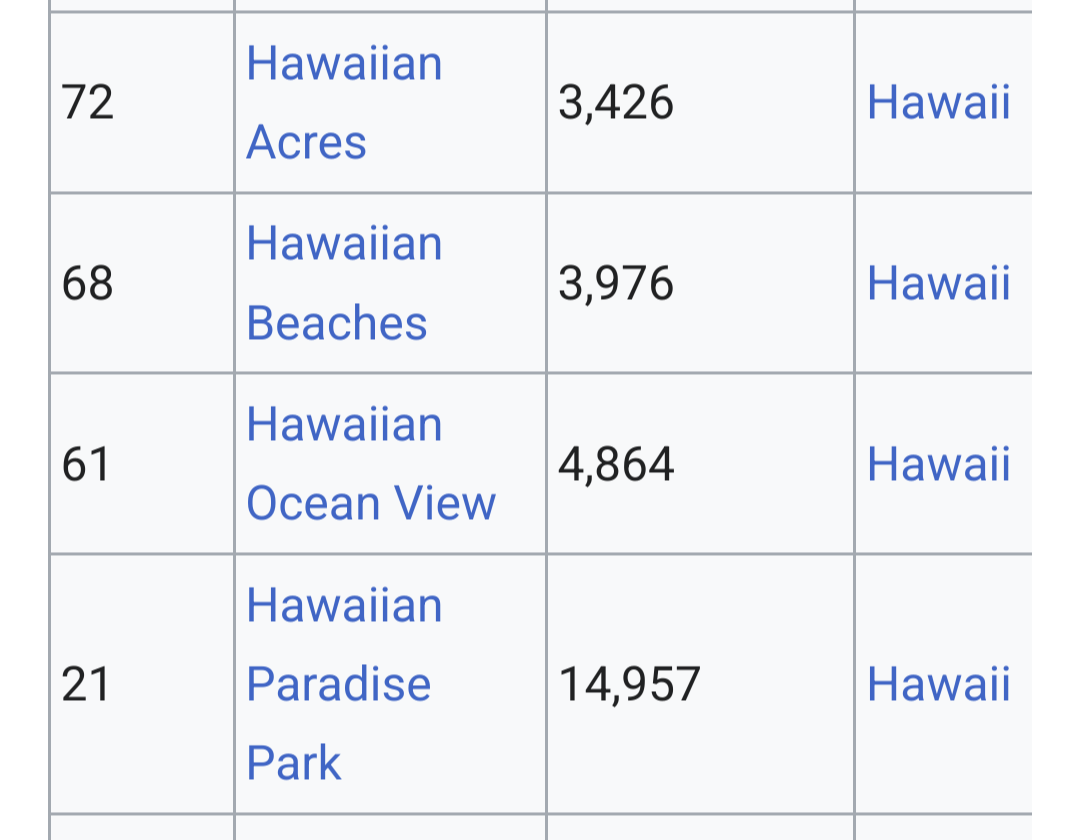- cross-posted to:
- map_enthusiasts@sopuli.xyz
- cross-posted to:
- map_enthusiasts@sopuli.xyz
It’s kinda damn cool no matter what! 😎
Gotta love how the mapmaker didn’t even try with Hawaii.
Hono, lulu, lola, kona, kaila, kili - fuck it, we ball, just send it out as-is!:-P

Oh as in the word “Hawaiian”? lol, I figured they just meant the language and gave up. Most town names I’m familiar with in Hawaii have Hawaiian-language names. Oahu, Kona, Hilo, Waikiki, Lahaina, Makawao, Hana…
Anyway, good sleuthing!
Removed by mod
NM:
Eldorado at Santa Fe
Santa Ana Pueblo
Santa Clara village
Santa Clara Pueblo
Santa Cruz
Santa Fe
Santa Rosa
Santa Teresa
Santo Domingo Pueblo (do we count this one? It is a matter of gender)It depends how sophisticated the algorithm.:-)
Many states insisting on things that they are not really about.
New Jersey: parks, Midwest: cities
New Mexico: Christmas
According to https://www.infographicsarchive.com/united-states-ranked-by-national-and-state-parks/ NJ has the 5th highest percentage of the state covered in national and state parks: 7.28%
Probably it’s what, ~200 years ago, they hoped would eventually happen!? (like Kansas “City”:-)
Surprised to see Texas isn’t Spanish.
Probably the names are too diverse? Dallas, Houston, Alamo, but they do have some like San Antonio.
While Texas may have a lot of Spanish place names, unlike NM using Santa a lot, and CA using San a lot, Texas just has Spanish names that do not include a similar word.
I love how one of the most iconic cities of the country has a pronoun. Are they gonna change it to The Wetlands too?
Which one(s)? Los Angeles? If so, naw, cause certain individuals don’t know how to read in Mexican (the proper term there is Spanish I know:-).
Edit: I forgot you said The Wetlands.
Las Vegas. Even the state name, which means Snowy, is in Spanish.
Hrm, so now by removing the pronoun, they will make it non-binary:-).
Minnesota checks out.
I’m not entirely sure. In my state (one of the ones shown as “city”), Wikipedia has 942 cities/towns listed and of those only 25 have “city” in their names.
I’m tempted to keep going to see how many Lake, Mount(ain), 'ville, 'burg, etc there are.
If despite the plethora of other words, City was the “mode”, then that would make sense. Or it could be adjusted for population, or otherwise biased towards whatever the definition of a “city” is to specifically exclude towns and the like?
In any case it’s kind of a neat graph to think about:-).
Only things with falls in NY are parks.
Why is city in so many places, every city is “city of” or “x city”. That’s not really the name though. There be way more of Town than City if thats how you did it.Glenn’s Falls is not a park
Ok. That’s one. Out of…?
Falls:
Brasher Falls-Winthrop
Glens Falls
Glens Falls North
High Falls
Highland Falls village
Honeoye Falls village
Hoosick Falls village
Hudson Falls village
Little Falls
Lyons Falls village
Montour Falls village
Niagara Falls
Oriskany Falls village
Rensselaer Falls village
Seneca Falls village South Fallsburg (should this one count?)
South Glens Falls village
Valley Falls village
Wappingers Falls village
West Glens FallsFor a total of 19, 20 if we count Fallsburg. Where city only has 6, however ville has 87, and village 557 listed. But I am unsure that the village is part of the place name.
https://www.alphalists.com/list/alphabetical-list-new-york-cities
Well, damn. Case closed lol
Enough said
Some places have City in the name of the place, like New York City, Oregon City, Rapids City. Sometimes the place really doesn’t seem large enough to merit the name, like Siler City, NC, although I suppose in the 19th century it was more prominent in its part of the state.
every city is “city of” or “x city”
I think a hasty generalization has led to a false assumption. Many cities are incorporated as “City of x” or “x City”. But, “many” is not equivalent to “all”.
And which does this map take into account?
Who knows. Would NYC even be considered one “city”, rather than a set of burroughs, for this purpose? Or are the names perhaps normalized by population? If so, would they remove outliers as many statistical packages will do for you, but in this case they should leave them in, so if they were removed automatically that would not be great. Or if they just went with one name = one count then is there a minimum cutoff? Or a nearness criteria e.g. places near NYC still get swept up into it? And like how much wood would a woodchuck chuck if a woodchuck could chuck wood? So many unanswered questions here…
Maybe I’m misunderstanding this, but I grew up in cental NC and this is only partially true. If you were going to the coast, yeah you’d say “I’m going to the beach”, then probably specify which beach. But, if you were just referring to any other place farther inland, you would most likely use it’s actual name because there are a lot of cities and small towns in relatively close proximity, so you’d have a lot of ambiguity otherwise.
I think it’s a bit more literal than that. They’re saying the names of towns and places have the word beach in them.
Yup. Live in Kansas and a bunch of tiny towns have city as part of their name. Dodge City, Baldwin City, etc.
I’m sure it’s true, but like, I don’t know any locations in Maine that follow the “new” trait. I do know of one or two that follow the “Island” trait though.
That is the only state that I see a gradient coloration for. If you were in the northern part of Maine, that might explain it? (Assuming the gradient was intended to mean literally north vs. south as opposed to more generically some parts vs. other parts)










